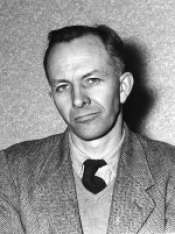Robert Row
Robert "Bob" Row (1915–1999) was an English fascist from Lancaster, a member of Oswald Mosley's British Union of Fascists (BUF) who was detained by the British government under Defence Regulation 18B during the Second World War. After the war he wrote and edited British fascist publications and remained a believer in Mosleyism until his death

Early life
Robert Row was born in 1915.[1] His father worked for Waring & Gillow and was sent to Cuba to decorate the House of Assembly.[2] He left school in 1931, by his own account during the Sterling crisis of that year when Britain left the Gold Standard. In 1998, he recalled a succession of low-paid jobs and an environment of boarded-up shops in his local high street during his youth. "The times were desperate and after more of the same I joined the Blackshirts in 1934" (the BUF).[3]
Fascist career
In Oswald Mosley's British Union of Fascists, Row saw policies that would put Britain first and "banish the slump".[3] He became highly active in the movement but with the outbreak of the Second World War, he was detained by the British government under the newly introduced Defence Regulation 18B.[4] He spent time at Walton jail. He was also held for a time at a prison camp near Huyton where the most prominent inmate was John Beckett. The two associated freely during their incarceration, although they argued regularly, Beckett having left the BUF in 1938.[5] He was released while the war was still on and joined the British Army, serving in Palestine.[2]
After the war, Row worked as an agricultural labourer in Surrey and began to send articles to Union, organ of the Union Movement, successor to the BUF, which was edited by Alexander Raven Thomson. In the early 1950s, Thomson appointed Row as deputy editor of Union and he became editor after Thomson's death in 1955. The paper became The National European in 1964 and Action in 1966 before the Union Movement also changed its party name to Action in 1973. He was editor of all of these titles until the closure of Sanctuary Press in 1992.[2] He also edited Lodestar with Jeffrey Hamm from 1985 to 1992.[6]
Row was assaulted or intimidated several times during his fascist activities. In 1963, six young men of the anti-fascist Yellow Star Movement broke into the Union Movement headquarters at 302 Vauxhall Bridge Road and assaulted Row and Keith Gibson, the movement's political secretary.[7] All six were arrested and later fined (one aged 16 was bound over) at the Old Bailey after pleading guilty to assault and causing damage to property.[8] According to testimony, Row was made to kneel on the floor and rip up copies of Action.[9] Both Row and Gibson required hospital treatment.[10] Soon after, according to Comrade, he was attacked again by the same group on his way home from work.[2]
Row was close to Raven Thomson politically and in the early 1950s supported his view that the Union Movement should move closer to the neo-Nazism that was gaining some support in Germany, rather than Mosley's unpopular "Europe a Nation" policy.[11] Later, with Jeffrey Hamm, he was a key figure in Action.[12] Increasingly, in the post-war decades, Row through his writings became a unifying force for the dwindling and ageing band of former BUF members as the movement engaged less in political action and more in rhetoric and nostalgia for the BUF.
Death
Row remained a committed fascist until his death, continuing to contribute to publications of the offshoots of the BUF until the end, such as Comrade, newsletter of the Friends of Oswald Mosley. He died in 1999 after a minor operation. He was 83. His ashes were scattered by his niece in Lancashire at a site where he and his brothers cycled in his youth.[2] He never married.
Selected publications
- Union Movement – The answer to the slump. Union, London, c. 1948.
- Sir Oswald Mosley: British patriot and national European. European Action, n.d.
- The coloured question in Britain: Cause and solution. Sanctuary Press, n.d.
References
- "British Union of Fascists (act. 1932–1940)", Julie V. Gottlieb, Oxford Dictionary of National Biography, Oxford University Press, online edition. Retrieved 20 November 2015. (subscription required)
- "One of those Blackshirts", Comrade, No. 53, December 2000, pp. 2–3.
- "Testimony of faith" by Robert Row in Comrade, No. 48, 7 February 1998, pp. 2–3.
- Warburton, John & Jeffrey Wallder. (2008) The Defence Regulation 18B British Union Detainees List. Revised edition. Friends of Oswald Mosley. p. 7.
- Beckett, Francis. (1999) The rebel who lost his cause: The tragedy of John Beckett, MP. London: Allison and Busby. pp. 183–184. ISBN 978-1902809045
- Gottlieb, Julie V.; Linehan, Thomas P. (Eds.) (2004). The culture of fascism: Visions of the far right in Britain. London & New York: I.B. Tauris. p. 232. ISBN 9781860647987.CS1 maint: extra text: authors list (link)
- "Two Hurt in Raid on Mosley H.Q.", The Times, 13 May 1963, p. 12.
- "Raiders of Mosley H.Q. Fined", The Times, 23 July 1963, p. 13.
- "Editor "Made To Kneel", The Times, 5 June 1963, p. 16.
- Hann, David. (2013). Physical Resistance: A Hundred Years of Anti-Fascism. Winchester: Zero Books. ISBN 9781780991771.
- Macklin, Graham (2007). Very deeply dyed in black: Sir Oswald Mosley and the resurrection of British fascism after 1945. London & New York: I.B. Tauris. p. 55. ISBN 978-1-84511-284-4.
- Barberis, Peter; John McHugh; Mike Tyldesley (2000). Encyclopedia of British and Irish political organizations: Parties, groups and movements of the 20th century. London & New York: Pinter. p. 174. ISBN 978-0-8264-5814-8.